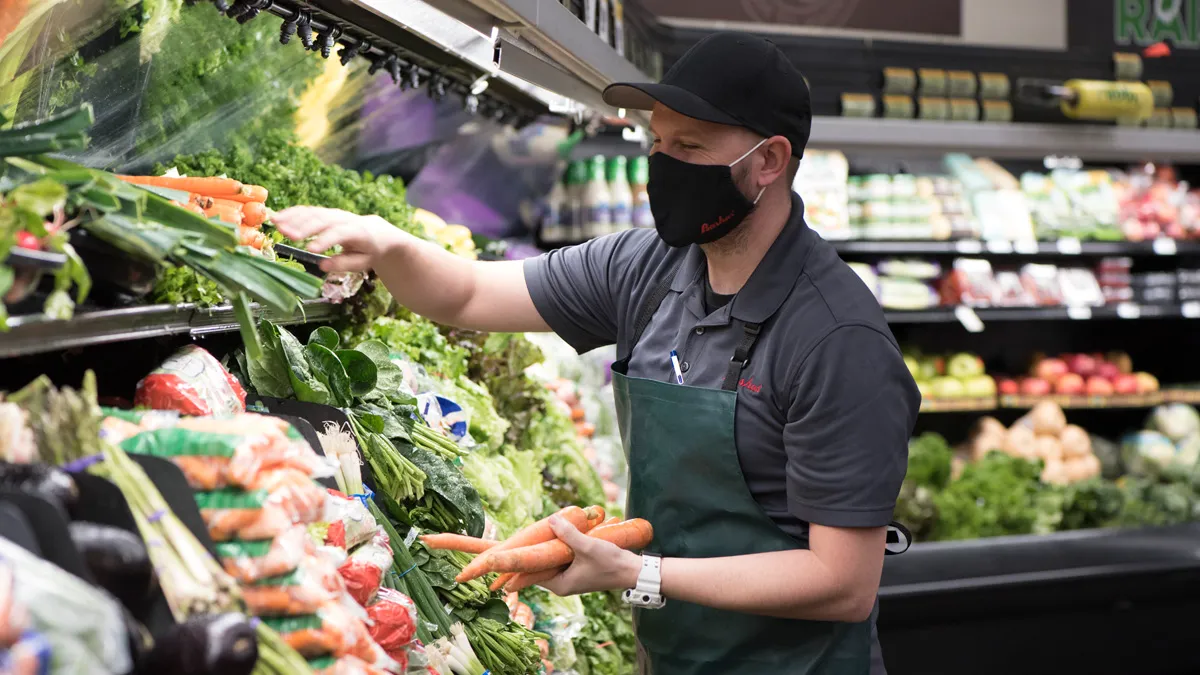Dive Brief:
- Eighty percent of retailers recently surveyed by the Food Industry Association (FMI) said they face hiring challenges that are negatively impacting their businesses, according to a newly released report from the trade organization.
- While the industry has been boosting worker incentives, with 85% of respondents saying they increased wages and benefits for full-time employees in 2020, retailers saw an overall turnover rate of 58%, up from 40% in 2019, The Food Retailing Industry Speaks report found.
- Grocers and food retailers are continuing to grapple with hiring and retention challenges as limited childcare options, safety concerns, the rise of the gig economy and increasing competition from restaurants strain the labor market.
Dive Insight:
Grocers have spent a significant amount of money on hiring and retaining workers during the pandemic. Of the $24 billion food retailers spent on pandemic-related expenses from March 2020 to March 2021, more than half went directly to employees, with $12 billion spent on increased pay and incentives, $5 billion on benefits and $1 billion on non-monetary benefits and vaccine incentives, FMI found.
Despite these investments, labor remains one of the industry's biggest pain points, said FMI President and CEO Leslie Sarasin.
“To attract both full- and part-time employees, retailers have offered a combination of higher wages, bonuses, improved benefits, flex time, and training and skills development opportunities,” Sarasin said during a press call on Wednesday. “Yet as we’ve seen across the entire labor market, these efforts just haven't been sufficient to help retailers recruit and retain sufficient labor levels.”
Harris Teeter has shortened all store hours from 6 a.m. to 9 p.m. due to the labor shortage, The Charlotte Observer reported, while Kroger CEO Rodney McMullen told CNBC recently that hiring is one of the biggest issues for the grocer, which has roughly 20,000 job openings: “We’re aggressively hiring anywhere we can. One of the biggest constraints we have right now is finding talented people,” he said.
The Speaks report, which was prepared by FMI and David Orgel Consulting, Inc., was based on a survey in April completed by 103 food retail and wholesale companies, representing approximately 38,000 stores.
The turnover rates for food retail workers last year were the highest over a seven-year period measured by FMI. Turnover for part-time employees was 74% in 2020, up from 52% in 2019. Turnover for full-time employees was 22%, up from 13%, and for corporate employee turnover was 15%, up from 11% in 2019, FMI found.
Boosting wages and salaries was the top measure grocers took to attract part-time and full-time workers, FMI found. Companies are also spending more on training, skills development, benefits and new perks like flextime. In all, food retailers spent almost $300 per employee on average for training and skills development in 2020, and 68% of respondents expect those costs to increase this year, FMI found. Roughly 70% said they expect their health care costs to increase in 2021.
Though respondents raised concerns about rising worker costs, the overall sales per labor hour, a metric used for retailer performance, increased to $188 in 2020, up from $155 in 2019 and the highest in the seven-year period analyzed by FMI.
Even as they face hiring and retention challenges, grocers' labor needs are also swiftly evolving across stores and corporate offices, FMI found. Fifty percent of respondents plan to boost staffing for data analytics or digital technologists, while 40% said the same for foodservice and 38% for delivery workers.
Meanwhile, 26% said they plan to decrease staffing for cashiers and front-end staff, and 14% said the same for in-store dining workers and 11% for scratch bakers or pastry chefs. E-commerce staffing had mixed results, with just over half saying they would increase staffing for in-store or curbside pickup workers or for online purchase fulfillment staffing, while 14% said they would decrease staffing for those roles.












